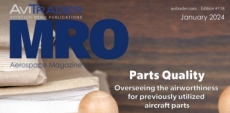

24/7 AOG Critical Response
Hotline![]() UK +44 1403 798888US +1 877 780 2008
UK +44 1403 798888US +1 877 780 2008
Our award winning global AOG service is manned 24 hours a day, 365 days a year.
Please call +44 1403 798888 or email aog@ajw-group.com.

25 Jan 2024

Amid parts scandals and supply chain issues, the aviation industry is looking to alternative sources, such as Used Serviceable Material, to boost inventory. This does beg the question, what measures are being taken to guarantee the quality of USM?
AJW Technical Director David Miret Mora speaks to David Dundas in the latest issue of AviTrader MRO Magazine about the challenges, industry standards and regulations, and best practices when sourcing USM.
The aviation industry is known for being highly regulated by authorities to ensure the constant safety of aircraft and passengers. Between regulations and documentations, all bases are covered, and mechanics trust that the used parts they install, meet the stringent quality requirements.
In this article, industry experts give the reader, and operators, the reassurance that the processes and procedures that are in place to maintain these standards, comply with regulations and certifications and that the use of USM is not something to be wary of nor avoided. It is a matter of building trust in the materials, say experts, trust in the parts and trust in the supply partner.
Miret Mora considers the key factors for airworthiness when sourcing USM, comprehensive assessment of the material integrity, previous usage history, adherence to industry standards, and compliance with regulatory requirements. “It is vitally important to maintain the integrity of the aviation industry and safeguard the well-being of all stakeholders,” he states.

Vendors, MROs, and USM suppliers must be subject to regular audits to reassure operators of the integrity of the USM to build the much-needed trust in the used material market. Robust vendor approvals are essential and airlines must audit and monitor their suppliers to gain the reassurance they need.
Discussing industry standards and best practices when dealing with the quality and safety of USM, the article speaks about meeting the mandatory EASA requirements and AJW’s Technical Director has clear ideas. “A comprehensive model that integrates safety, quality, and reliability is essential. Each element is crucial not only for regulatory compliance but also for effectively mitigating safety risks.”
Miret Mora adopts a cautious approach to current challenges regarding the verification of part authenticity and believes, “collaboration and information sharing among stakeholders can further establish best practices for material identification and reporting, thereby leading to a more reliable system.”